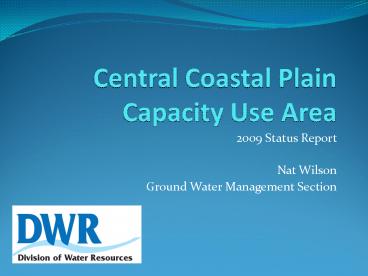Central Coastal Plain Capacity Use Area - PowerPoint PPT Presentation
Title:
Central Coastal Plain Capacity Use Area
Description:
Alternative water sources will make up for reductions and allow for growth. CCPCUA Web Resources ... can be made by comparing these two types of data. ... – PowerPoint PPT presentation
Number of Views:52
Avg rating:3.0/5.0
Title: Central Coastal Plain Capacity Use Area
1
Central Coastal Plain Capacity Use Area
- 2009 Status Report
- Nat Wilson
- Ground Water Management Section
2
CCPCUA Map
- 15 counties in the central portion of the Coastal
Plain - Currently 218 permit holders and 72 registrations
3
CCPCUA Requirements
- Within the CUA ground water use above 100,000
gallons per day requires a permit - Ground water withdrawals between 10,000 and
100,000 gallons per day require annual
registration - Surface water withdrawals above 10,000 gallons
per day require annual registration - Reporting of daily withdrawals, water levels
chloride concentrations
4
CCPCUA Reductions
- Cretaceous Zones Declining Water Level,
Dewatering, and Salt Water Encroachment - Approved Base Rate (ABR)
- Water users required to reduce withdrawals
between 2002 and 2018 by 30 to 75, in three
phases, from ABR
5
CCPCUA Compliance
- Regional independent alternative water supplies
- Surface water
- Shallower wells
- Better water treatment capability
- Investment of hundreds of millions of dollars
6
Compliance Enforcement
- We know that those complying are investing
millions of dollars in their water systems, and
they expect compliance by all other permit
holders.
- As a result of a 2009 legislative bill, penalty
assessments can be as high as 1,000 per day
7
CCPCUA Compliance
- Reductions over 16 year period should lead to
sustainable rate of withdrawal from Cretaceous
aquifers - Alternative water sources will make up for
reductions and allow for growth
8
CCPCUA Web Resources
- On-line access to ground water levels, withdrawal
data, and reporting tools - CCPCUA web page link off the DWR homepage,
www.ncwater.org - Ground Water Data web page link off the DWR
homepage - The 2004 CCPCUA Status Report (pdf)
- The 2008 CCPCUA Assessment Report (pdf)
- The 2009 CCPCUA Status Report (pdf)
9
Permit Data
10
Production Wells
11
Water Levels
12
Withdrawals
13
CCPCUA Web Resources cont.
- Status of alternative water supply development in
the CCPCUA as of June 19, 2008 (pdf) - Neuse Regional Water and Sewer Authority serves
Lenoir County, and part of Pitt County with
treated Neuse River water. This project became
operational in Fall 2008. - Greenville Utilities will supply treated Tar
River water to several new customers including
Greene County and the Town of Farmville. The
transmission lines to these two communities will
be constructed by late 2009. - Many other non-regional solutions described in
2009 Status Report
14
Latest Monitoring Results
- DWR constantly reviews water withdrawals and
water levels to track the aquifers ever-changing
responses. - Interesting observations can be made by comparing
these two types of data. - Lets look at three examples in the NRWASA
service area.
- Daily water withdrawals are summed in a 10-mile
circle surrounding a monitoring station. - Three Black Creek aquifer wells at three stations
in Lenoir County are illustrated in the following
charts.
15
(No Transcript)
16
(No Transcript)
17
(No Transcript)
18
(No Transcript)































